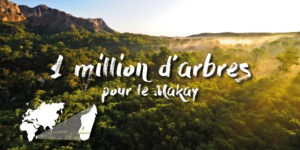After launching a pilot beekeeping project in 2018, Naturevolution is starting a reforestation project near the villages of Makay: 1 Million trees for Makay. But we could not launch this project without first explaining to you how it fits into the specific context of the Makay and into a worrying global context. Through 6 articles we take stock of the current state and causes of deforestation in the world, in Madagascar and the Makay, what governments are doing to combat it, about reforestation initiatives around the world and in Madagascar, and finally about the most impactful actions that an individual can have to fight against deforestation. Quite a programme!
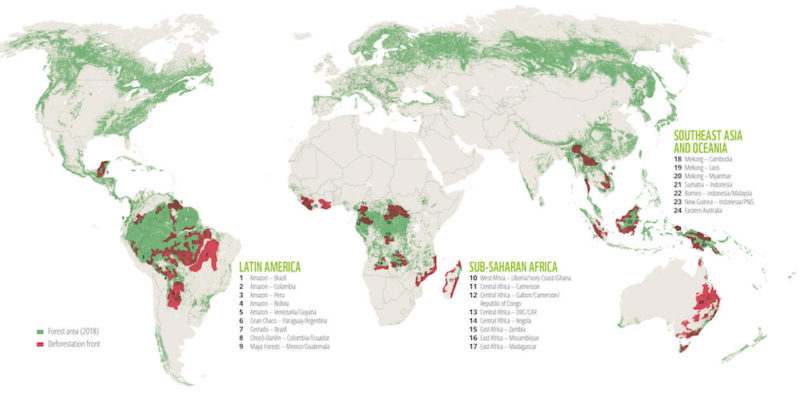
Source : WWF, rapport Deforestation Fronts : drivers and responses in a changing world, 2021.
A worrying trend
Deforestation caused by the development of human activities is not a recent phenomenon. Long before the development of agriculture, Homo sapiens already had a considerable impact on forests, but the low population density and the mobility of hunter-gatherers allowed forests to regenerate to some extent.
On the other hand, it is extremely worrying that massive deforestation continues into the 21st century in a context of scarcity of forest areas rich in biodiversity, a crisis of extinction and rapid global warming. Considered “out of control” in many countries of the world, is today’s deforestation not the result of our lifestyle choices?
The phenomenon has even worsened in some countries. In Brazil, for example, where deforestation had decreased dramatically until 2012, thanks to political will (linked in particular to the expansion of protected areas) and the use of satellite imagery, deforestation has started again.
In June 2019, a significant acceleration of deforestation in the Amazon was reported by the National Institute of Space Research of Brazil (INPE). In one month, 920 km2 of rainforest have disappeared. At the end of 2019, INPE noted that deforestation in Brazil doubled in 2019 compared to 2018, a direct consequence of the messages of the Brazilian president. A setback that does not bode well for biodiversity and indigenous peoples precisely at a time when the European Union has just signed a free trade agreement with the states of South America (Mercosur), an agreement described by Nicolas Hulot as “a complete contradiction to our climate ambitions”.
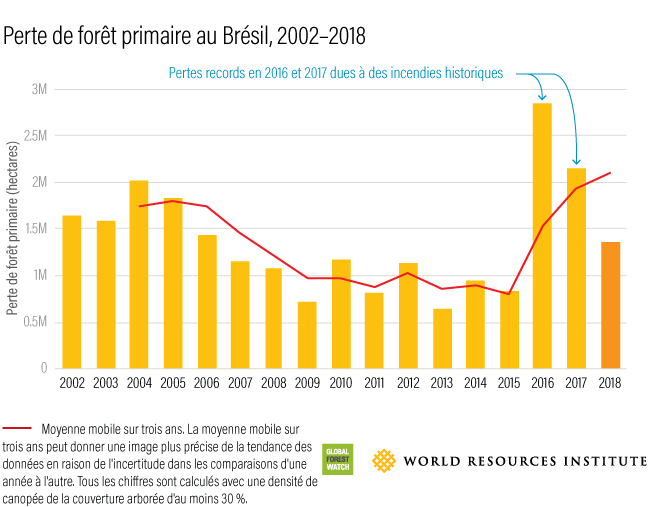
What do the numbers say?
According to Global Forest Watch annual report, In 2018, the world lost 12 million hectares of tropical forests, of which 3. 64 million were primary tropical forests, the equivalent of Belgium! This is the fourth worst year in terms of rainforest deforestation, after 2016, 2017 and 2014 since the first records were made in 2001.
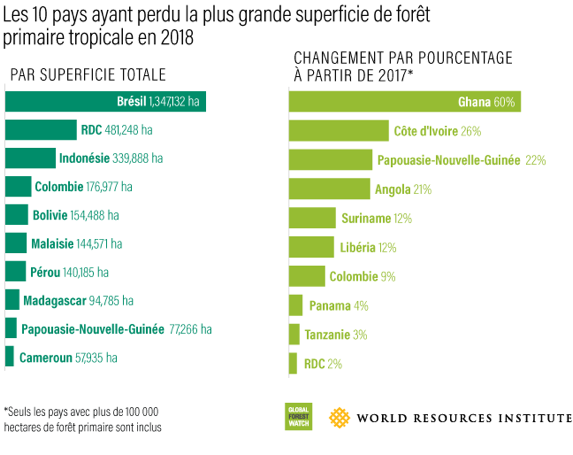
The countries most affected by deforestation are Brazil, Indonesia and the Democratic Republic of Congo (DRC) – three countries that account for almost 60% of the world’s tropical forests. Some forests have long been spared due to decades of civil wars, such as in Colombia, the DRC or Myanmar (Burma), but as these conflicts end or slow down, these forests are seen as new opportunities for exploitation.
Beware of interpreting the numbers!
You may have heard of an 88% increase in deforestation in Brazil from at least June 2019 or a 278% increase in July 2019 in the press. We recommend Mongabay’s article, which explains why the media’s interpretation of these figures is inaccurate and helps Brazilian President Bolsonaro question scientific institutions.
Different causes in different continents
According to the FAO’s 2016 State of the World’s Forests report, nearly 80% of global deforestation is caused by agriculture (30-35% for subsistence farming and 45-50% for commercial or industrial farming) and 20% by infrastructure construction, mining and urbanization. But the causes of deforestation differ radically from continent to continent.
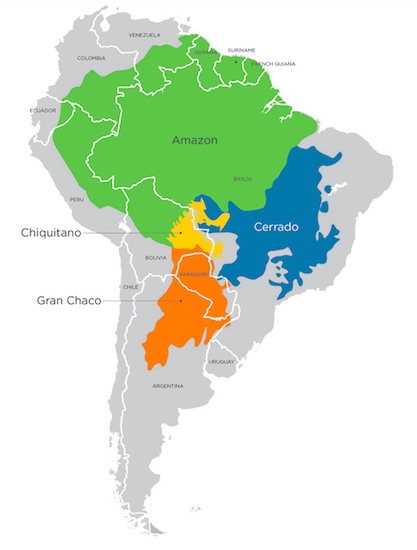
South America
If we still look at the case of Brazil, the causes of deforestation in 2018 were 65-70% the creation of pastures for livestock (Brazil exports a lot of beef) and 25-30% for agriculture (especially the export of soybeans to China and Europe for their livestock). Infrastructure, mining and forestry, and urban expansion account for only a small fraction of deforestation.
The situation is similar in other countries (Bolivia, Peru, Colombia, Paraguay, etc. ) and not only in the Amazon basin. Moins connus, Gran Chaco and Cerrado are increasingly affected by deforestation.
The Gran Chaco, which straddles several countries, is home to the largest dry forest in Latin America, as well as savannas and wetlands. The Cerrado, located mainly in Brazil, is a huge tropical savannah made up of many types of natural habitats – forested savannah, wet savannah, gallery forests, etc. – and hosts an extremely rich and diverse biodiversity. These two areas, less subject to political pressure than the Amazon, are experiencing unprecedented deforestation, mainly caused by Europe.
South-East Asia
In Indonesia and Malaysia, palm oil is the driving force behind deforestation. In the Mekong region (Thailand, Cambodia, Laos, Vietnam), rubber plantations are used mainly for the manufacture of tires. Other commodities also destined for export join them: for example Java pepper on the island of Sulawesi, or coffee in Vietnam.
Unlike Latin America, much of Asia’s deforestation is also due to local agriculture and, to a lesser extent, to infrastructure development, urban expansion and mining.
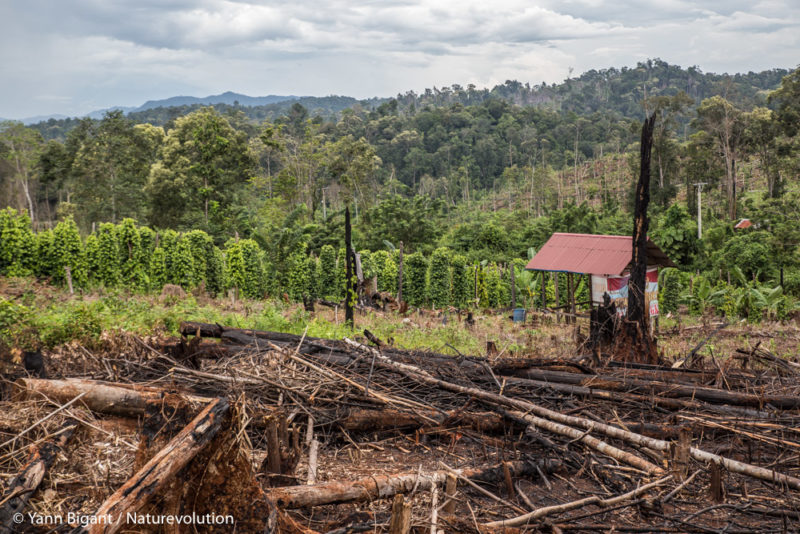
Africa
Most of Africa’s deforestation is caused by smallholder farmers producing local subsistence agriculture. This is particularly the case in Madagascar, where deforestation is caused by clearing the forest for burning crops (tavy) or for the production of charcoal for cooking.
But that’s changing.. For the past decade or so, the forests of Central and West Africa have been seen as the ‘new Eldorado’ of industrial agriculture, where virgin forests can be replaced by plantations that meet the demand for commodities on the international market. Forests in Congo, Cameroon and Gabon threatened by palm oil expansion. In Côte d’Ivoire and Ghana, even protected areas are being deforested to produce cocoa for export.
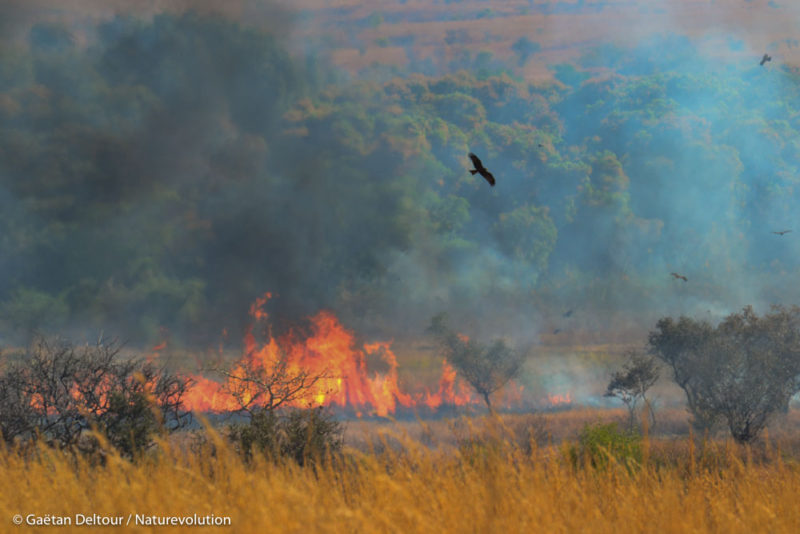
Australia
More rarely mentioned, Australia is the only developed country among the top 10 deforestation hotspots, due to a lack of political will and inadequate laws. Again, the main reason for deforestation is the expansion of pastureland for beef production, as well as the development of commercial plantations and the clearing of forests for the paper industry, including primary forests in Tasmania. Australia is home to a unique endemic biodiversity and some of the oldest forests in the world. Deforestation threatens at least 700 Australian animal and plant species, including iconic species such as the koala.
What are the prospects for the future?
The future looks bleak for large tropical forests and their biodiversity. Subject to many local anthropogenic pressures (deforestation for agricultural expansion, degradation by logging, poaching), in addition to that of climate change, which increases the risk of fires and forces species to move rapidly (300 metres/year), Of the large tropical forests, there could remain only a few highly degraded fragments at the end of the century.
Confronting government inaction on deforestation,there is an urgent need for action and many resources are available. Read more in this article : How can we take action against deforestation ?
Our partners

An initial financing of €10,000 was obtained from Maltem, allowing the launch of the project 1 Million Trees for Makay. Maltem is an ecosystem of consulting companies specialising in digital transformation and sustainable innovation, and a partner of Naturevolution since 2016.
The whole series of articles
- (1/6) Deforestation: a state of play in 2019
- (2/6) Deforestation: chronology of government (in)action?
- (3/6) Reforestation: opportunities and limitations
- (4/6) How to act against deforestation ?
- (5/6) Deforestation in Madagascar and the Makay massif
- (6/6) Why protect the forests of Makay ?
An article written by Gaëtan Deltour and Yann Bigant


